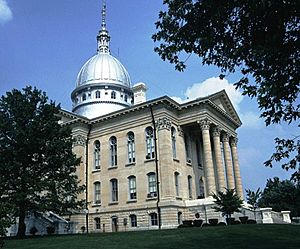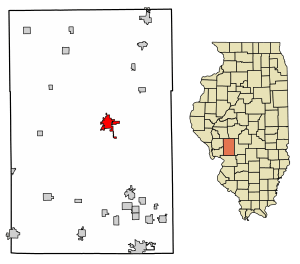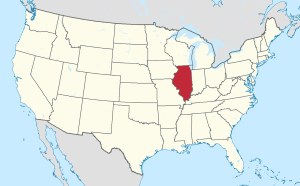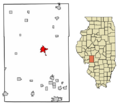Carlinville, Illinois facts for kids
Quick facts for kids
Carlinville, Illinois
|
|
|---|---|

Macoupin County Courthouse in Carlinville
|
|

Location in Macoupin County, Illinois
|
|
 |
|
| Country | United States |
| State | Illinois |
| County | Macoupin |
| Townships | Carlinville Brushy Mound |
| Founded | 1865 |
| Area | |
| • Total | 3.37 sq mi (8.72 km2) |
| • Land | 3.37 sq mi (8.72 km2) |
| Elevation | 617 ft (188 m) |
| Population
(2020)
|
|
| • Total | 5,710 |
| • Density | 1,694.86/sq mi (654.48/km2) |
| Time zone | UTC-6 (CST) |
| • Summer (DST) | UTC-5 (CDT) |
| ZIP code |
62626
|
| Area code(s) | 217 |
| FIPS code | 17-11202 |
| GNIS feature ID | 2393743 |
| Wikimedia Commons | Carlinville, Illinois |
Carlinville is a city in Illinois, USA. It's the main city, or county seat, of Macoupin County. In 2020, about 5,710 people lived here.
The city is home to Blackburn College, a small school linked to the Presbyterian church. Carlinville was also once home to Prairie Farms Dairy.
Contents
Carlinville's History
Carlinville is named after Thomas Carlin. He was the 7th Governor of Illinois. He helped create Macoupin County when he was part of the state legislature.
Famous Courthouse
Carlinville has a long and interesting history. Many important people, including those hoping to become president, visited the city. They often stopped here because of the railway routes.
The most famous building in Carlinville is its courthouse. When it was built in 1870, it was the largest courthouse outside of New York City. Elijah E. Myers, a famous architect who designed state capitol buildings, created it. The courthouse was so expensive to build that people started calling it "The Million Dollar Courthouse." Its high cost even made Carlinville a possible location for the State Capitol.
Sears Catalog Homes
In the early 1900s, Carlinville became known for its many Sears Catalog Homes. These were houses that people could order from a catalog and have built. In 1918, Standard Oil of Indiana paid about one million dollars to build a whole neighborhood of these homes for its mineworkers in Carlinville.
Because of this, Sears, Roebuck and Company named one of their house models the "Carlin." Today, 149 of the original 156 homes are still standing. This makes Carlinville the largest collection of Sears Catalog Homes in the United States.
Insect Study
A notable resident of Carlinville was Charles Robertson. He was an American scientist who studied insects. He did the most detailed study ever of insects that visit flowers in one place, which was Carlinville.
His work led to a 221-page book called Flowers and Insects in 1928. From the insects he collected, he named over 100 new types of bees and wasps. Later, in the 1970s, other scientists studied the area again. They found that most of the bees Robertson noted were still there. This is likely because of natural areas like hedgerows and slopes that provide good homes for bees.
Other Famous People
Other famous people from Carlinville include Mary Hunter Austin, a writer. She was once called "the most intelligent woman in America" by H.G. Wells. Many other important military leaders and politicians also came from Carlinville.
Carlinville's Geography
Carlinville covers about 2.99 square miles (7.75 square kilometers) of land.
Carlinville's Population
| Historical population | |||
|---|---|---|---|
| Census | Pop. | %± | |
| 1880 | 3,117 | — | |
| 1890 | 3,293 | 5.6% | |
| 1900 | 3,502 | 6.3% | |
| 1910 | 3,616 | 3.3% | |
| 1920 | 5,212 | 44.1% | |
| 1930 | 4,144 | −20.5% | |
| 1940 | 4,965 | 19.8% | |
| 1950 | 5,116 | 3.0% | |
| 1960 | 5,440 | 6.3% | |
| 1970 | 5,675 | 4.3% | |
| 1980 | 5,439 | −4.2% | |
| 1990 | 5,416 | −0.4% | |
| 2000 | 5,685 | 5.0% | |
| 2010 | 5,917 | 4.1% | |
| 2020 | 5,710 | −3.5% | |
| U.S. Decennial Census | |||
In 2000, Carlinville had 5,685 people living in 2,125 households. About 31.1% of these households had children under 18. The average household had 2.38 people. The median age in the city was 37 years old.
Getting Around Carlinville
Roads
Illinois Route 4 runs north to south through Carlinville. Interstate 55 is about 12 miles east of the city. Illinois Route 108 also passes through Carlinville. It connects Interstate 55 to the east with Kampsville to the west. In Kampsville, you can cross the Illinois River on a free, state-run ferry.
Trains
The Carlinville Amtrak station has five trains stopping daily. This makes it easy to travel south to St. Louis or north to Springfield and Chicago. One of these trains is the Texas Eagle. It connects Chicago to Texas and has special cars for sleeping, dining, and relaxing.
Freight trains also use the tracks in Carlinville. These trains carry goods instead of people. In the past, different railway companies used these lines.
Old Electric Train Line
The Illinois Terminal Railroad was an electric train line. It used to run down the middle of West Street in Carlinville. This line carried both goods and passengers. It even carried freight trains to a nearby grain elevator into the 1970s. Part of this old line is still used by a coal company today.
Notable People from Carlinville
- Walter Stratton Anderson (1881–1981), U.S. Navy vice admiral
- Mary Hunter Austin (1868–1934), writer
- Dana J. Boente (1954– ), General Counsel of the FBI
- William A. Boring (1859–1934), architect
- Frank W. Burton (1857–1934), Illinois state judge
- Kelsey Card (1992- ), Olympic discus thrower
- Louis P. Daley (1868–1930), Illinois state representative
- Vince Demuzio (1941–2004), Illinois state senator
- Palemon Howard Dorsett (1862–1943), plant scientist
- Cornelius J. Doyle (1871–1938), Illinois Secretary of State
- David Gore (1823–1911), Illinois state senator
- Mark Juergensmeyer (1940– ), religious scholar
- Truman H. Landon (1905–1986), U.S. Air Force general
- Louis John Lanzerotti (1938- ), physics professor
- Gustave Loehr (1864–1918), co-founder of Rotary International
- Peter F. Mack Jr. (1916–1986), congressman
- William Moise (1922–1980), artist
- William L. Mounts (1862–1929), Illinois state legislator and mayor
- John M. Palmer (1817–1900), 15th Governor of Illinois
- John McAuley Palmer (1870–1955), U.S. Army general
- Charles Robertson (1858–1935), insect scientist
- Richard Rowett (1830–1887), Civil War officer
- W. O. Woods (1873–1951), Treasurer of the United States
Images for kids
See also
 In Spanish: Carlinville (Illinois) para niños
In Spanish: Carlinville (Illinois) para niños




